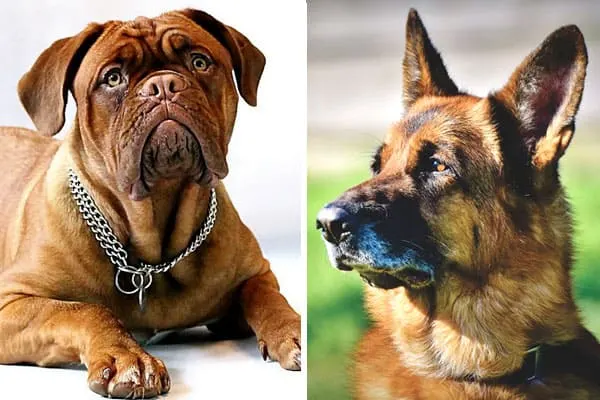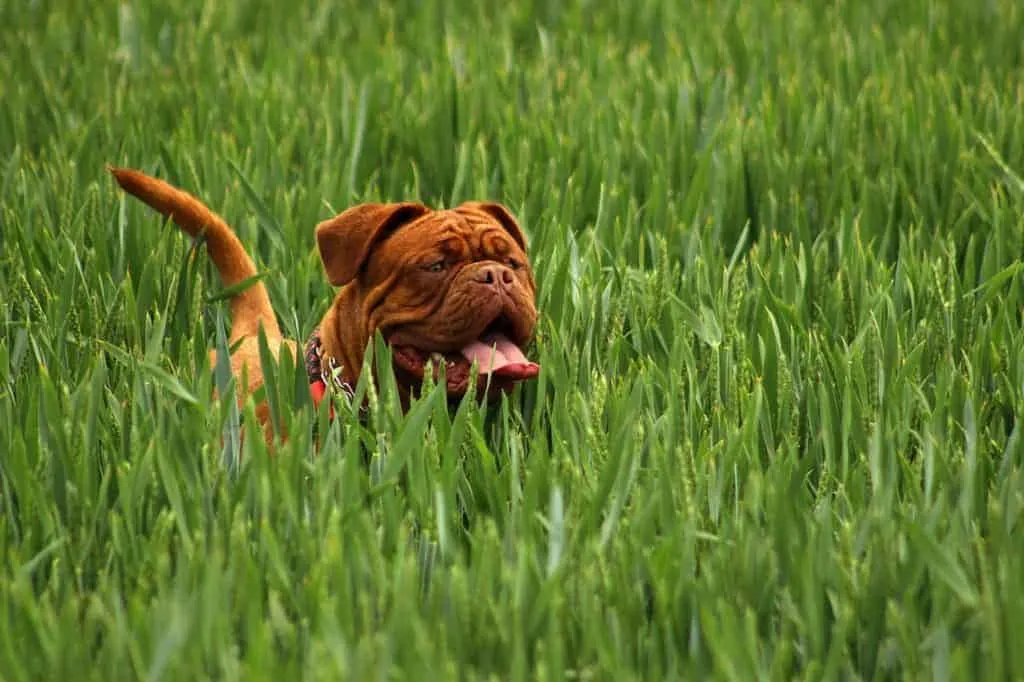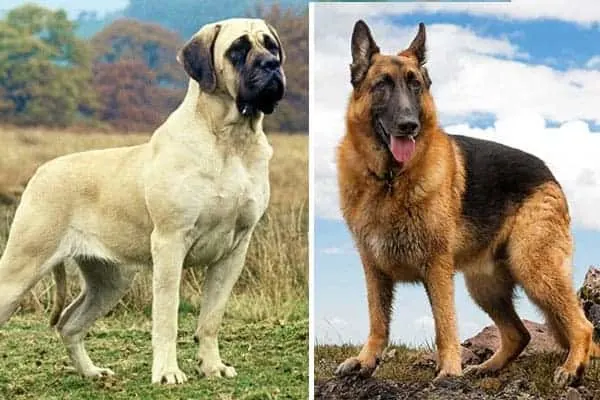German Shepherd Mastiff Mix: How Can This Rare Mix Make A Great Family Dog?
Combining the majestic Mastiff with a German Shepherd results in a large and formidable working dog with guarding ability and athleticism.
German Shepherd Mastiff mixes, like other designer dogs, frequently combine the most desirable qualities from two breeds that on the surface may not seem to have much in common.
A German Shepherd Mastiff mix is an uncommon hybrid that is most often fawn, black, or brindle.
The German Shepherd Mastiff Mix is a loyal and affectionate pet with moderate energy levels, high drive, focus, intelligence, and territorial tendencies.
If you are lucky enough to acquire a Mastiff Shepherd, you must establish control early on mastiff dogs, and focus heavily on socialization and training.
Your commitment to your German Shepherd Mastiff mix should ultimately lead to a polite and well-behaved dog that is gentle and protective with your children, and retains the level head and versatility of an exceptional working animal.

What are the origins of the parent breeds?
Evident in the name, the Mastiff Shepherd is a cross between a German Shepherd and a Mastiff. A German Mastiff is another possible nickname but more often describes the Great Dane.
German Shepherds have a prominent working background
The German Shepherd is a relatively new mastiff breed.
German Shepherds did not come into their own as a distinct breed until 1899 with ex cavalry officer Max von Stephanitz and a medium yellowish sable dog named Hektor Linksrhein from Karlsruhe.
Hektor, who became Horand after Stephanitz’s acquisition, was a Thuringian region Shepherd who happened to have exceptional herding abilities.
However, many Thuringian types were too aggressive, prey-driven, and intense to be good working dogs.
They also were difficult to train, and so Stephanitz incorporated herding dogs from the Wurttemberg and Swabian regions to balance Shepherd’s working ability and add focus, hardiness, versatility, trainability, and stamina.
The Mastiff is an ancient breed
There are several types of german shepherd and mastiff, but the variation people most commonly associate with the German Shepherd mix is the Mastiff with English roots. Other possibilities are as follows.
- Neopolitan Mastiff – Creates a more aggressive mix
- Cane Corso – A quick and agile mix with frequent blue and black and tan offspring
- Dogue de Bordeaux
- Tibetan Mastiff – Rare mix
The English german shepherd and mastiff, usually just Mastiff, may have ancestors in the Roman gladiator arena dogs who fought bears and lions as early as the 500s BC. Scientists have not yet proven an ancestral link.
Historians are more certain about the Mastiff descending from the Pugnaces Britanniae of Phoenicians from Asia about 550 BC and possibly Molossers of Roman conquerors in 55 BC.
Mastiffs likely received further influences from the Alaunt of the Normans around 1070 AD.
Similarly to many breeds, Mastiffs almost went extinct during World War II with meat rations. Many of them and their parent breeds also succumbed to distemper.
The revival of the breed involved a lone surviving female and about 15 other dogs.
The female, named Nydia of Frithend, may have been part Bull Mastiff, and subsequent matches to preserve the Mastiff breed included outcrossing with Saint Bernards, a Dogue de Bordeaux, and possibly others.
Historically, Mastiffs served as catch dogs for wild game, namely boars, and as guard dogs for estates.
They also battled in wars, baited bulls, participated in dogfights, and guarded livestock through various phases of their evolution.
What does the German Shepherd Mastiff Mix look like?
Your German Shepherd Mastiff mix will receive physical traits to varying degrees from both parents.
From German Shepherd
The German Shepherd is about 22 to 26 inches high at the shoulders with a long, powerful neck, and strong sloping shoulders. She is somewhat longer than tall and weighs between 50 and 95 pounds.
Show and working lines differ in the slope from withers to hips, conformation champions usually illustrating exaggerated hind leg or pelvic angles.
The head of the German Shepherd is large but noble with a somewhat square but long muzzle and upright ears.
German Shepherds have a thick double coat that is usually short or medium in length. They also have a long bushy tail.
Experts classify German Shepherd colors as standard, faulted, or disqualified. White Shepherds and the extremely rare panda German Shepherd cannot show, but the AKC and UKC allow their full registration.
All washed-out and dilute colors such as cream, blue, Isabella, and liver are serious faults in sanctioned AKC conformation classes.
Standard colors are the classic black and tan and red and tan, bicolor, solid black, red sable, and wolf grey or agouti. Many Shepherds have s black facial mask.
Looks From Mastiffs
The Mastiff, as his name implies, should look impressive in size. Mastiffs stand 27.5 to 30 inches tall at a minimum and weigh 120 to 230 pounds.
Females can be much smaller than males without penalties as long as they still appear powerful.
Mastiffs are almost square with a level back, broad powerful chest, and a massive head. The ears are relatively small and folded and the eyes wide-set.
Unlike German Shepherds, Mastiffs have a short, broad, and very deep muzzle. Their tails are rather short and thick and rope-like.
Acceptable colors for Mastiffs are fawn, apricot, and brindle. Fawn can range from cream to silvery tan, and apricot is any shade of red from light orange to deep reddish-brown.
All Mastiffs, even brindle dogs, should have black facial masks.
Show ring judges prefer brindle dogs to have uniform striping, but the bands are often less distinct.
Incomplete striping, or reverse brindle, is a serious fault if not a disqualification for a Mastiff. Nonstandard colors are rare and include blue, chocolate, pied, and cream.
German Mastiff Appearance
Your German Mastiff will be a large dog from 25 to 36 inches tall that weighs 80 to 200 pounds.
Her head will be large and round with a broad muzzle not as deep as a Mastiff’s nor as long as a German Shepherd’s. The ears may stand up but will more likely be semi-prick and larger than a Mastiff’s.
Expect your Shepherd Mastiff cross to be barely longer than tall with a moderate brush on the tail.
Brindle, if the genes are present, is dominant to any agouti colors which include fawn, sable, black and tan, bicolor, and recessive black.
Fawn is dominant over the other agouti colors. Therefore, your German Mastiff will most likely be fawn or brindle and have a black mask.
However, recessive black is a rare trait in the Mastiff. It can appear in a puppy who also receives a recessive black gene from the German Shepherd parent.
Uncommonly, your pup could be black and tan or chocolate.
What should you know about German Shepherd Mastiff Mix temperament?
German Shepherds and Mastiffs both have distinct personalities, and your mix can show an unpredictable blending of the two types. Shepherd mastiff mix temperament is explained below
Guard Potential
German Shepherds have shown flock protectiveness that extends to the household and family from their earliest working days.
Historical breeders selected for dogs with a guarding instinct and German Shepherds quickly became one of the primary breeds for guard dogs duty in homes.
The German Shepherd continues to be a top guard dog choice.
Despite its reputation, no German Shepherd should be an indiscriminate biter, given to unprovoked attacks.
A German Shepherd should have a solid character that is fearless and unwavering but give plenty of warning before a justified act of aggression.
You can usually attribute inappropriate aggression in Shepherds to certain family lines (poor breeding), improper socialization, abuse, or neglect (lack of meaningful attention).
While historically territorial and protective of home and property as well as ferocious in war, modern Mastiffs have seen selection for level-headedness and docility.
Most people consider them intimidating but gentle giants. Nevertheless, they make excellent watchdogs.
Mastiffs will protect family members if they sense a threat. A Mastiff, like several other breeds, often takes his behavioral cues from his owner.
If you are relaxed and friendly, your Mastiff will treat your guests cordially.
Shepherd mastiff usually move between perceived danger and their owner, according to Thedogplace.org, and only bite as a last resort. Her huge size makes it rare that a Mastiff has to attack.
She also has a formidable bark to deter ill intent.
Like German Shepherds, Mastiffs have certain family lines that are predisposed to shyness or atypical aggression.
Your German Mastiff should be friendly with strangers or slightly aloof. She will remain relaxed as long as she perceives a cordial relationship between you and your guests.
Although intimidating and equipped with ferocious threat posturing, your mix should be very unlikely to bite. Your German Shepherd Mastiff mix will most of the time be an extremely effective watchdog.
Occasional individuals will also be good guard dogs, although you can train the majority of them for some type of protective work.
Getting Along With Other Dogs
Mastiff’s gentle nature extends to other animals and children. According to Vetstreet.com, a well-socialized Mastiff can get along with other dogs and even cats.
Nevertheless, their large size necessitates your supervision at all times around small pets and little kids.
German Shepherds readily learn that children and other animals in the household warrant their protection. They tend to be tolerant and even gentle around toddlers.
However, German Shepherds do not necessarily extend kindness to anyone outside the family circle and often exhibit aggression against other dogs and suspicion towards strange children.
Some have a strong drive to chase moving objects.
Use caution with your Shepherd mix around other animals and children until you can gauge her disposition. Most will be fine if you supervise them around children and dogs within your household.
Socialize your dog properly and she will be more likely to be able to also play appropriately around your friends’ children and dogs at the park.
Does a German Shepherd Mastiff Mix shed a lot?
German Shepherds and Mastiffs are year-round moderate shedders and your mix will not be much different.
Besides, your Shepherd Mastiff mix is likely to have a dense undercoat that he may “blow” seasonally in the spring and fall.
Like Mastiffs and Shepherds, your dog will do well in cold weather as long as not for prolonged periods under 30 degrees Fahrenheit.
Your hybrid will probably not do as well in warm weather as a purebred German Shepherd. With their shortened snouts and large size, some Mastiffs can be sensitive to the heat.
Mastiffs only need weekly brushing while German Shepherds require you to brush them up to four times a week.
Your Shepherd Mastiff mix will have a moderately dense double coat with possible fringes and ruffs on some parts.
She will require you to brush her probably two or three times a week and every day when she is shedding her undercoat.
What are German Shepherd Mastiff Mix health concerns?
Your German Shepherd Mastiff mix is likely to live eight to twelve years, a little longer than many giant breeds.
Dogs from Shepherd and Mastiff ancestry most commonly suffer from hip and elbow dysplasia, bloat, bleeding disorders, obesity, and urinary tract infections which lead to bladder stones.
Hip and elbow dysplasia starts during growth and can lead to crippling arthritic changes later. Overnutrition in puppies is a leading risk factor in dogs with the genes for dysplasia.
Improper exercise and obesity can increase the severity of developmental disorders.
Large- and giant-breed dogs are exceptionally susceptible to bloat because of their deep chests and the volume of food they must eat.
Once a dog’s stomach swells with fluid or gas, it can rotate, leading to life-threatening heart effects and electrolyte imbalances.
Feeding one huge meal a day or raising your dog’s food bowls increases the risk of GDV exponentially.
How much exercise should you give your German Shepherd Mastiff Mix?
German Shepherds require two hours of daily exercise, while Mastiffs only need 40 to 60 minutes.
Your German Shepherd Mastiff mix will be happy and healthy with 45 to 90 minutes of activity a day. It is always ideal to split exercise sessions into at lease two intervals a day.
Also, it is important to engage your dog’s mind with training, adventurous deviations from the routine, and socialization, as well as her body.
German Shepherd mixes require periods of strenuous exercise to keep up with their high energy levels.
Mastiff Shepherds will probably not have quite the speed and grace of pure German Shepherds, but they should still perform well in agility, tracking, and Shutzhund.
Many of them will also do well in some military operations, drug-sniffing, physical assistance, and search and rescue.
What can you learn about intelligence and training?
While pet owners actively seek German Shepherds for their intelligence and reputed obedience, Petrix.com and Stanley Coran’s list of intelligence in working dogs ranked Mastiffs in one of the low-scoring groups with Beagles.
Indeed, Mastiffs have a reputation for stubbornness.
You can expect your German Shepherd Mastiff to have better responsiveness, obedience, and working drive than a purebred Mastiff.
However, you can also anticipate that your puppy will have a stubborn streak and may show the German Shepherd’s pushiness.
Examples
This video shows a pretty classic example of a Mastiff Shepherd with large size, head that is somewhere between a Mastiff’s and a German Shepherd’s, and ears that are floppy but too large for a purebred Mastiff.
Note the fawn color and picture-perfect black facial mask. The mixed puppy’s coat is smoother than a German Shepherd’s would be.
Frequently Asked Questions
How big will a German Shepherd mastiff mix get?
The size of a German Shepherd Mastiff mix can vary greatly. However, these are typically big dogs! You can expect these mixed breeds to reach between 1.9 feet to 3 feet tall when standing or 0.6 to 0.9 meters.
They will usually weigh between 80 to 200 pounds or 36 to 91kg, making them heavy german shepherd dogs too! Of course, most people will struggle to pick these dogs up, but that doesn’t stop us trying, does it?
As these are mixed breeds, it’s hard to give a definite answer about their size. It will depend on their parents and whether they have been mixed with other breeds in the past.
Of course, their lineage goes a long way into determining their size, but usually, as fully grown adults, these are big german shepherd dogs that are sure to be the big spoon every night!
How long do German Shepherd mastiffs live?
German Shepherd Mastiffs tend to live for between nine to eleven years.
However, it is common for large breed german shepherd dogs to have a shorter life expectancy than shorter dogs, mainly due to their size and health complications.
Typically, we see German Shepherds on their own, reaching up to 13 years of age, but it’s more common that they live for less time than this.
When mixed to become German Shepherd Mastiff mixes, that life expectancy is shortened to eleven years maximum.
You will, of course, find some dogs that will live longer than this suggestion, but these are few and far between.
Providing they live healthy and happy lives with the right amount of exercise and don’t suffer any injuries or illnesses.
Your Mastiff mix can live for up to eleven years relatively problem-free! Their health and lifestyle will also determine their life expectancy.

What do you call a german shepherd mastiff mix?
You can call a German Shepherd Mastiff mix a German Shepherd Mastiff mix, or you can refer to them with some of their other names.
They are commonly referred to as a GSD Mastiff, a German Mastiff Shepherd, or an English Mastiff Shepherd.
If you use any of those names when talking to a dog or breed enthusiast, chances are they will know what you are talking about!
Sometimes people also refer to these breeds as a German Shepherd X English Mastiff cross.
Whichever of these names that you use is perfectly fine and clearly describes these beautiful cross breeds well.
When it comes to deciding on a name for your German Shepherd Mastiff mix, you can use any name you see fit.
Whether it’s a traditional dog name or a more unusual one, we are sure it will suit your dog perfectly!
What does a Mastiff German Shepherd mix look like?
What Mastiff German Shepherd mixes look like does vary from dog to dog. This is mainly due to the variety of Mastiffs which will dictate and change the appearance of these dogs.
Once fully grown, they can look very different from one another.
Typically, these dogs will have large paws, a robust muzzle, and folded ears. As we saw from their size, they tend to be large dogs with large abdomens and a soft coat.
Their coat color also varies too from light to dark, with many being ginger or brunette. The length of their coat also varies, with many being long if not regularly groomed.
No matter their appearance, these mixed dogs are always beautiful creatures and are sure to be welcome additions to your home.
So why not check out some pictures of these beautiful dogs and prepare to cry at their cuteness?





















